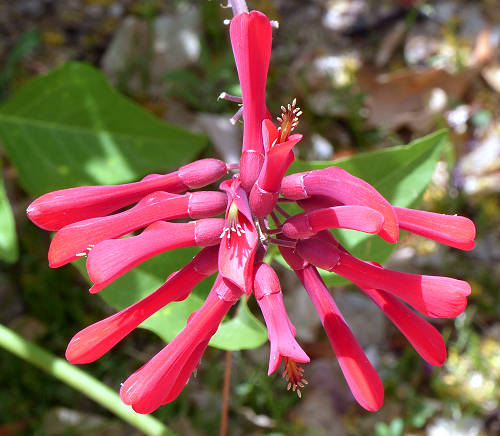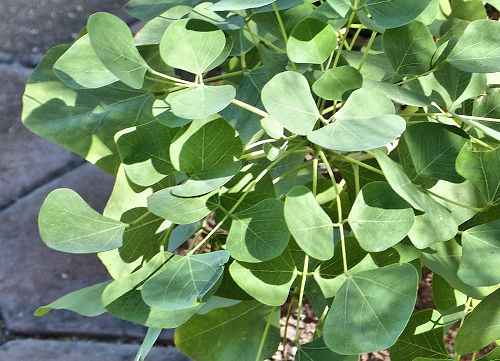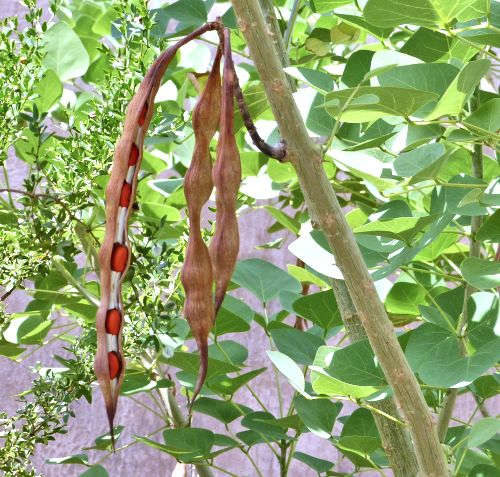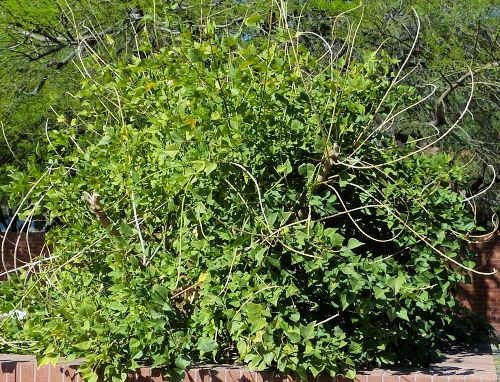Growing Erythrina flabelliformis:
Coralbean
Description
Form: A shrub or small tree sometimes categorized as a semi-succulent.
Leaf retention: Deciduous.
Growth rate: Moderate to rapid.
Mature Size: 5-15' (1.5-4.5m) high and 4-12' (1.2-3.7m) wide.
Flowers: Red, tubular, 3" (7.6cm) long, in clusters.
Bloom: Late winter or spring, often before leaves emerge.
Fruit: Long brown seed pods, containing bright red to orange toxic beans.
Leaves: Green, fan-shaped leaflets appear in the summer rainy season. The plant is leafless most of the year unless watered.
Stems: Gray to light brown, curved, woody, somewhat swollen for water storage, with short curved thorns. The stems may freeze to the ground in winter but will re-sprout from their roots. First year stems do not produce flowers.
Roots: Large and swollen to provide water storage. Nitrogen-fixing*.
Wildlife: The flowers attract hummingbirds.
Toxic / Danger: All parts of this plant are toxic, especially the colored beans. The stems and leafstalks have thorns.
Origin: Arizona, New Mexico, and Mexico.
Form: A shrub or small tree sometimes categorized as a semi-succulent.
Leaf retention: Deciduous.
Growth rate: Moderate to rapid.
Mature Size: 5-15' (1.5-4.5m) high and 4-12' (1.2-3.7m) wide.
Flowers: Red, tubular, 3" (7.6cm) long, in clusters.
Bloom: Late winter or spring, often before leaves emerge.
Fruit: Long brown seed pods, containing bright red to orange toxic beans.
Leaves: Green, fan-shaped leaflets appear in the summer rainy season. The plant is leafless most of the year unless watered.
Stems: Gray to light brown, curved, woody, somewhat swollen for water storage, with short curved thorns. The stems may freeze to the ground in winter but will re-sprout from their roots. First year stems do not produce flowers.
Roots: Large and swollen to provide water storage. Nitrogen-fixing*.
Wildlife: The flowers attract hummingbirds.
Toxic / Danger: All parts of this plant are toxic, especially the colored beans. The stems and leafstalks have thorns.
Origin: Arizona, New Mexico, and Mexico.
Cultivation and Uses
USDA hardiness zones: 10-11 for best flower production. Root hardy to zone 9.
Heat tolerant: Yes.
Drought tolerant: Yes.
Sun: Full sun to part shade.
Soil: Well draining, pH 6.6-7.8 (neutral to slightly alkaline). *Do not use a nitrogen fertilizer.
Water once established: Monthly. Twice a month to weekly may encourage leaves and/or flower production.
Planting: Coralbean may be grown in a container. It is best placed in full sun with a southern exposure and protected from freezes.
Prune: After the last freeze of winter, remove frost damage.
Litter: Leaf drop during dry periods.
Propagation: Seed or cuttings.
Uses: Hummingbird plant, ornamental.
USDA hardiness zones: 10-11 for best flower production. Root hardy to zone 9.
Heat tolerant: Yes.
Drought tolerant: Yes.
Sun: Full sun to part shade.
Soil: Well draining, pH 6.6-7.8 (neutral to slightly alkaline). *Do not use a nitrogen fertilizer.
Water once established: Monthly. Twice a month to weekly may encourage leaves and/or flower production.
Planting: Coralbean may be grown in a container. It is best placed in full sun with a southern exposure and protected from freezes.
Prune: After the last freeze of winter, remove frost damage.
Litter: Leaf drop during dry periods.
Propagation: Seed or cuttings.
Uses: Hummingbird plant, ornamental.
Comments
This plant is a member of the Legume family (Fabaceae). Other common names are Coral Bean and Chilicote. Flowers appear on the previous year's undamaged stems. If winter freeze damage occurs, this plant may not flower. It may never flower in a region with yearly freezes.
Do you have additional information or a different experience for these plants that you would like to share? Email info@GardenOracle.com. All contributions are welcome and appreciated.
This plant is a member of the Legume family (Fabaceae). Other common names are Coral Bean and Chilicote. Flowers appear on the previous year's undamaged stems. If winter freeze damage occurs, this plant may not flower. It may never flower in a region with yearly freezes.
Do you have additional information or a different experience for these plants that you would like to share? Email info@GardenOracle.com. All contributions are welcome and appreciated.





Latest update: February, 2019
© 2008-2025 by GardenOracle.com

